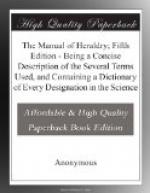An attempt was made to revive these martial exhibitions in Scotland, a few years ago, by Lord Eglintoun, the acknowledged leader in all manly sports, elegant athletic exercises, and baronial liberality. This noble peer proclaimed a tournament to be held at Eglintoun Castle on the 28th and 29th of August, 1839. The lists were duly prepared, a covered pavilion was erected for the accommodation of the ladies, which would contain 3000 persons. In front of this pavilion was the throne of the Queen of Beauty and her attendants. Around the lists, at convenient distances, were arranged the tents or pavilions of the knights, over which floated the gonfalon, or great banner, emblazoned with the arms and motto of the knight to whom the tent was appropriated, penons and penoncils fluttered at each angle of the pavilion, and the shield was placed over the entrance. The knights vied with each other in the decoration of their pavilions; all was in accordance with ancient customs: and if the shade of Froissart had witnessed the scene, it could not have complained of modern innovation or misplaced ornament. The procession of the King of the tournament, the Queen of Beauty, with the judges, heralds, pursuivants, halberdiers, musicians, men-at-arms, as also the splendid retinues of the noble challenger and the gallant knights, presented a scene unparalleled for magnificence and heraldic emblazonment since the days of Edward IV. Every form was observed in this modern tournament; and a more interesting scene for the historian, the antiquary, and armorist, could not be exhibited. Unfortunately, the continued rain cast a gloom over this animated spectacle, which nevertheless excited the highest admiration of all who beheld it: a spectator of the scene could well imagine the enthusiasm similar ones would create in the minds of the gay and brave of former times. It is deemed necessary to briefly notice the last tournament held in Britain; as any one that requires full information on every part of heraldic ornament, processional arrangement, and technical definition, may find positive examples in the details of this gorgeous exhibition.
TRANSPOSED. Charges or bearings placed contrary to their usual situation.
[Illustration: Transposed]




